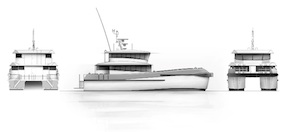(WASHINGTON) — Major domestic and international firms involved in the development of the first U.S. offshore wind farms need confidence in the availability of proven vessel concepts, as they continue to explore opportunities and justify investment decisions in the growing sector.
Further collaboration between firms in the supply chain will be essential in ensuring that lessons learnt in design from the mature markets are effectively transposed, and that offshore wind developers and equipment manufacturers have no doubt in the ability of U.S. shipyards and operators to deliver the standard, and volume, of vessel support they need to bring projects to fruition.
That is, at least, according to United Kingdom-based Chartwell Marine, a pioneer in next generation vessel design that has been highly influential in the development of the first crew transfer vessels (CTVs) for the U.S. market. The firm has recently launched the Chartwell 24, a new CTV design that responds to the specific demands of offshore wind manufacturers, developers and operators.
Despite the need to create confidence with familiar designs, there is still room for innovation, and substantial opportunities exist for those who can optimize vessels for U.S. market conditions. In particular, meeting EPA Tier 4 air quality requirements with bespoke propulsion options, hull and deck designs that stand up to larger Atlantic swells, and the ability to respond to unique development approaches with enhanced logistical support capacity, will be crucial advantages.
“There are a multitude of risks involved in establishing a presence in a new market – particularly for a sector as technologically demanding and complex as offshore wind,” said Andy Page, managing director, Chartwell Marine. “So, while major developers and operators have recently given U.S. offshore a huge vote of confidence, their focus is squarely on risk management – and de-risking vessel support will be high on the list of priorities.”
“Given the influence of the Jones Act on the production and cost of new vessels – plus stringent environmental and operational requirements – there needs to be a really strong business case for investment. The good news is that the U.S. maritime supply chain is well-placed to respond to this – providing it can maintain an ongoing dialogue with offshore wind firms about their specific needs, and demonstrate a capacity to take proven vessel concepts from the European sector, refine them and apply them successfully in U.S. waters.”
The Chartwell 24 design has been developed off the back of discussions with CTV operators, wind farm owners and turbine manufacturers, responding directly to lessons learnt in the construction and long-term operations and maintenance (O&M) phases of European projects. It is optimized to deliver the crucial attributes of safety, reliability and availability in testing conditions – and, with its unique four-engine propulsion, is well-placed to help operators meet US emissions standards.
For more information, visit www.chartwellmarine.com.

